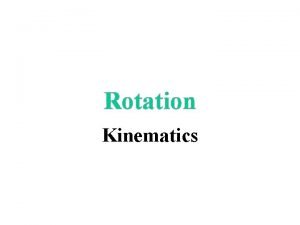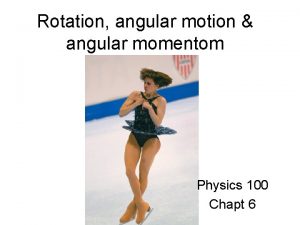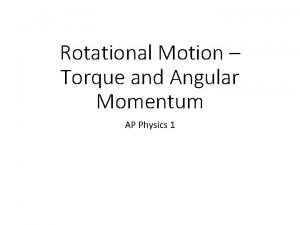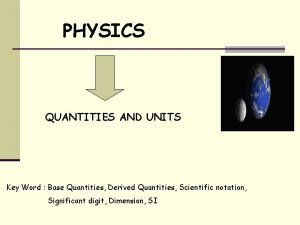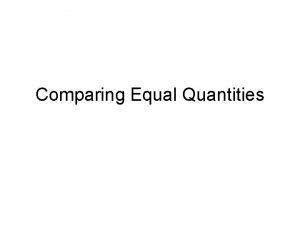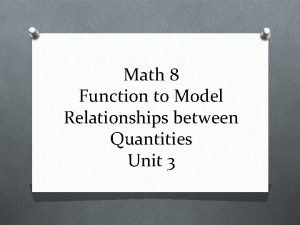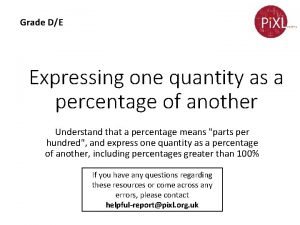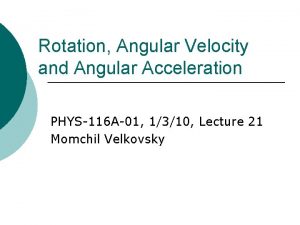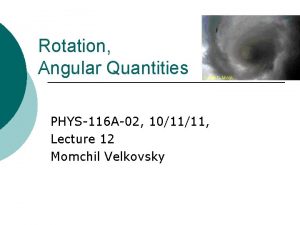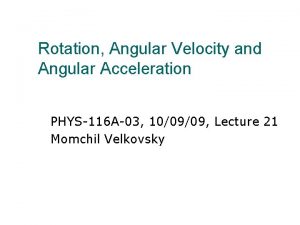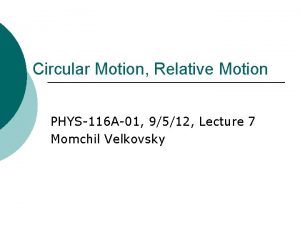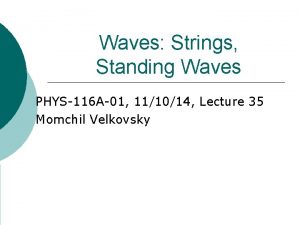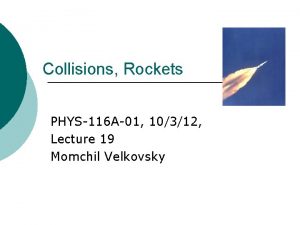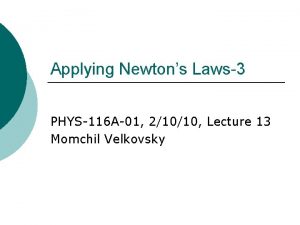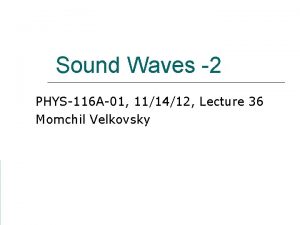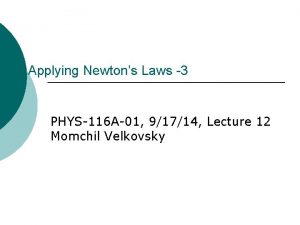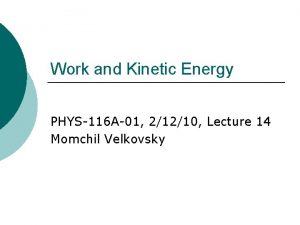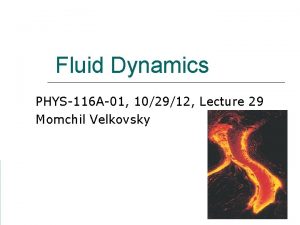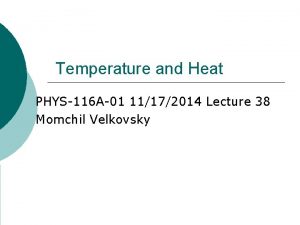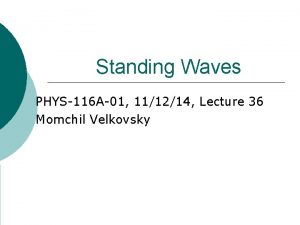Rotation Angular Quantities PHYS116 A01 1062014 Lecture 21



















- Slides: 19

Rotation, Angular Quantities PHYS-116 A-01, 10/6/2014, Lecture 21 Momchil Velkovsky

Rockets

Rockets

Rain starts to fall vertically in a railway car that was moving with velocity v. What is going to happen with the velocity of the car? 1. 2. 3. 4. 5. It will increase, horizontal momentum is conserved It will decrease, vertical momentum is conserved It will increase, total energy is conserved It will stay the same, because vertical drops do not add to the horizontal momentum

Angular motions in revolutions, degrees, and radians • One complete cycle of 360° is one revolution. • One complete revolution is 2π radians. • Relating the two, 360° = 2 π radians or 1 radian = 57. 3°.

Angular velocity, Angular acceleration ¡ The angular velocity is the angle swept out divided by the time it took to sweep out the angular displacement. ¡ Angular velocity is measured in radians per second (SI standard) as well as other measures such as r. p. m. (revolutions per minute).

Some more rotational kinematics y R r q x

Some more rotational kinematics y R r q x

Compared to a gear tooth on the rear sprocket (on the left, of small radius) of a bicycle, a gear tooth on the front sprocket (on the right, of large radius) has ¡ ¡ ¡ A. a faster linear speed and a faster angular speed. B. the same linear speed and a faster angular speed. C. a slower linear speed and the same angular speed. D. the same linear speed and a slower angular speed. E. none of the above

The graph shows the angular velocity and angular acceleration versus time for a rotating body. At which of the following times is the rotation speeding up at the greatest rate? ¡ ¡ ¡ A. t = 1 s B. t = 2 s C. t = 3 s D. t = 4 s E. t = 5 s

Rotations and vectors in 3 d Rotations do not commute! ¡ Any motion in 3 d that has a stationary point has a stationary axis: i. e. it is a rotation ¡ Infinitesimal rotations commute: they are described by vectors ¡ Angular velocity is a vector ¡

Angular velocity is a vector • You can visualize the position of the vector by sweeping out the angle with the fingers of your right hand. The position of your thumb will be the position of the angular velocity vector. This is called the “right-hand rule. ”

A DVD is rotating with an ever-increasing speed. How do the centripetal acceleration arad and tangential acceleration atan compare at points P and Q? ¡ ¡ A. P and Q have the same arad and atan. B. Q has a greater arad and a greater atan than P. C. Q has a smaller arad and a greater atan than P. D. P and Q have the same arad, but Q has a greater atan than P.

We have three fundamental equations for the kinematics of constant angular acceleration

Rotational energy ¡ Just like linear kinetic energy is ½ mv 2, the angular energy will be determined by ½ Iω2.

Finding the moment of inertia for common shapes

Extended bodies and the Parallel Axis Theorem

How to calculate I ?

Reading for next time Chapter 3. 8 (vector product) Chapter 11. 1 -11. 7
 Angular acceleration and linear acceleration
Angular acceleration and linear acceleration Rotational kinematic equations
Rotational kinematic equations Right hand rule physics angular momentum
Right hand rule physics angular momentum How to calculate optical activity
How to calculate optical activity Theorem of angular momentum
Theorem of angular momentum 01:640:244 lecture notes - lecture 15: plat, idah, farad
01:640:244 lecture notes - lecture 15: plat, idah, farad Base and derived quantities
Base and derived quantities Quantity expressions with specific nouns
Quantity expressions with specific nouns Equal comparison examples
Equal comparison examples Engineering science definition
Engineering science definition Similarity between scalar and vector
Similarity between scalar and vector Magnetic quantities
Magnetic quantities Sweden and norway use equal quantities of resources
Sweden and norway use equal quantities of resources Relationships between quantities
Relationships between quantities 30 examples of vector quantities
30 examples of vector quantities When multiplying and dividing measured quantities
When multiplying and dividing measured quantities Chapter 10 chemical quantities practice problems answer key
Chapter 10 chemical quantities practice problems answer key A quantity that has magnitude or size
A quantity that has magnitude or size Capturing quantities
Capturing quantities Expressing one quantity as a fraction of another worksheet
Expressing one quantity as a fraction of another worksheet

